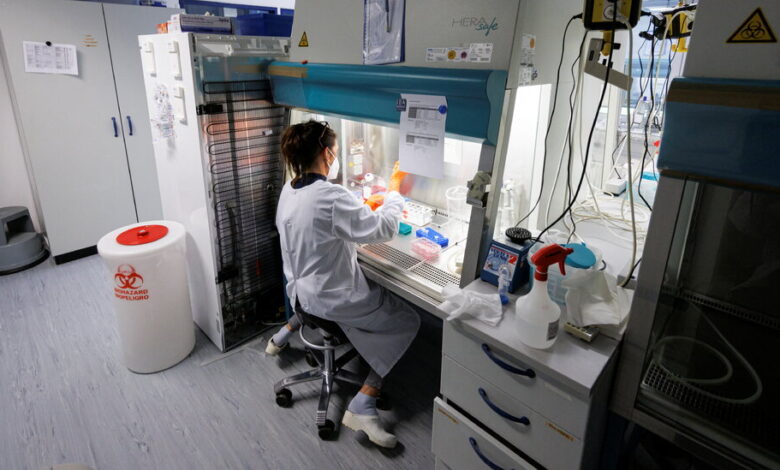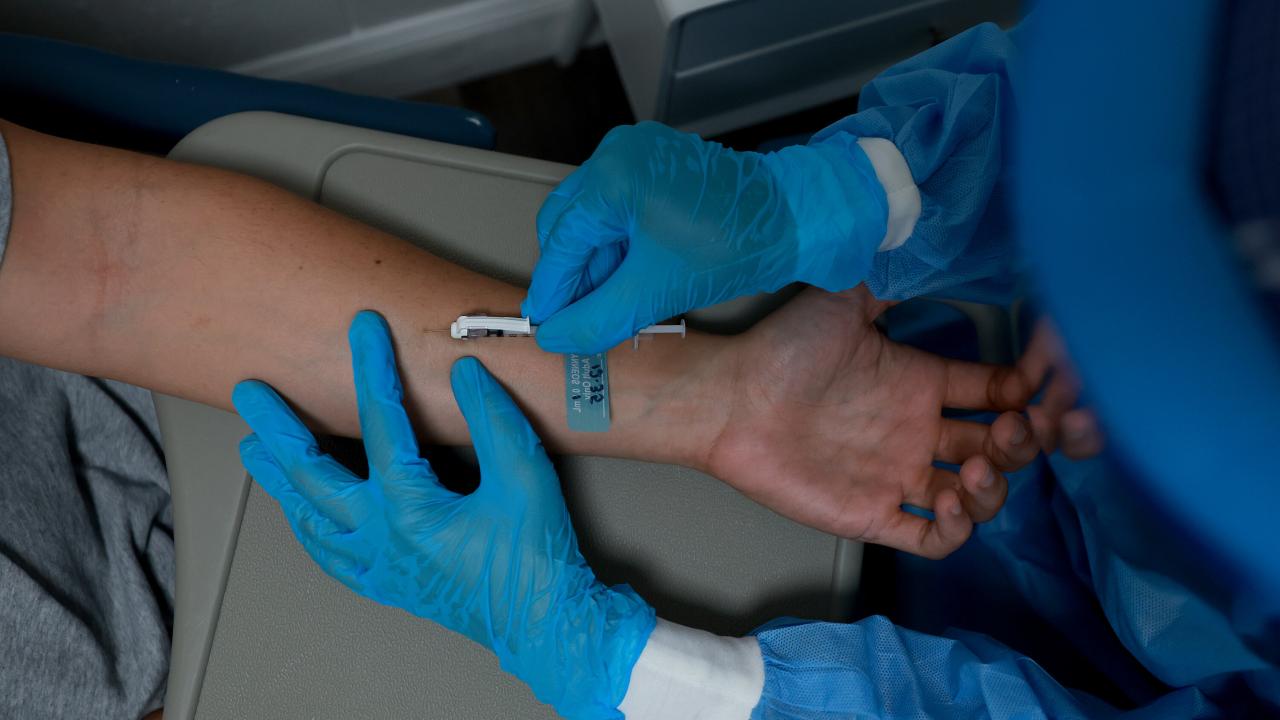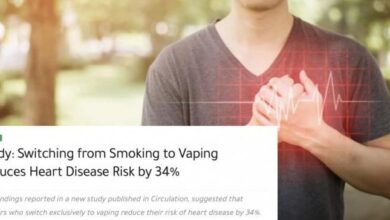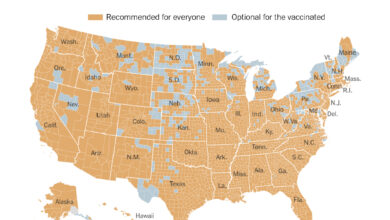
Officials investigate if they can stretch single monkeypox vaccine dose into 5 doses. This innovative approach could dramatically increase vaccine accessibility, potentially saving countless lives. The current approved regimen for monkeypox vaccination presents challenges in terms of supply and distribution, especially given the recent global outbreak. Scientists are exploring whether a single dose can be effectively stretched into multiple doses, potentially leading to a more efficient and economical approach to vaccination campaigns.
The research delves into the immunological mechanisms behind the monkeypox vaccine, exploring the potential efficacy of smaller doses administered over time. This investigation also considers the logistical, ethical, and safety implications of stretching the dose. The analysis will cover everything from the historical context of monkeypox and its vaccines to the regulatory hurdles in approving a stretched-dose regimen.
Background on Monkeypox Vaccine
Monkeypox, a viral zoonotic disease, has been recognized for decades, with outbreaks in various parts of the world. Historically, outbreaks were often sporadic and contained to specific regions, but recent global surges have highlighted the need for proactive public health strategies, including vaccination programs. Understanding the vaccine landscape is crucial for informed discussions on optimizing vaccine deployment and combating the spread of this disease.
History of Monkeypox
Monkeypox virus, first identified in 1958, is known to have circulated in animal populations for a long time. Early outbreaks in humans were linked to contact with infected animals. The virus’s zoonotic nature means it can jump from animals to humans, highlighting the importance of understanding animal reservoirs. Recent outbreaks, particularly the 2022 global outbreak, have emphasized the need for effective human-to-human transmission control strategies, including vaccination.
Current Approved Monkeypox Vaccine Regimens
Currently, the primary approved monkeypox vaccine regimens utilize the modified vaccinia Ankara (MVA) strain. These regimens typically involve two doses administered 28 days apart. This two-dose regimen aims to establish a robust immune response, but this schedule is not universally applicable and may need adjustments based on specific circumstances. The vaccine’s effectiveness in preventing infection or mitigating disease severity is a key factor in the evaluation of these regimens.
Rationale Behind Exploring Dose Stretching
The potential for dose stretching of the monkeypox vaccine stems from the desire to maximize vaccine coverage and potentially improve access. Limited vaccine supply and logistical challenges, especially in the context of global outbreaks, have driven the exploration of dose-stretching strategies. The rationale behind this approach lies in the hope of extending the impact of available doses to a wider population, potentially preventing more cases.
Potential Benefits and Risks of Stretching the Vaccine Dose
Potential benefits of dose stretching include wider vaccine coverage, reduced vaccine shortages, and improved accessibility in resource-constrained settings. However, there are also potential risks. The effectiveness and safety of dose stretching protocols remain to be thoroughly investigated. There’s a concern that reduced immunogenicity, or the ability to generate an immune response, might compromise protection against monkeypox. Therefore, a thorough evaluation of efficacy and safety in different populations is crucial.
Comparison of Monkeypox Vaccine Types and Dose Schedules
| Vaccine Type | Manufacturer | Dose Schedule | Notes |
|---|---|---|---|
| Modified Vaccinia Ankara (MVA) | Various | Two doses, 28 days apart | Currently the most commonly used regimen |
| Imvanex (Imvamune) | Bavarian Nordic | Two doses, 28 days apart | Specific details on dose stretching may vary |
This table provides a basic overview. Further research is needed to determine the optimal dose stretching strategies for different populations and contexts. The safety and efficacy of alternative schedules need to be carefully evaluated.
Scientific Rationale for Dose Stretching
The prospect of stretching a single dose of the monkeypox vaccine into multiple smaller doses presents a compelling strategy for increasing vaccine accessibility and potentially broadening its reach. This approach could be particularly valuable in regions with limited vaccine supply or logistical challenges. However, the scientific underpinnings of such a strategy require careful consideration and rigorous testing. Understanding the immunological mechanisms of the vaccine, potential efficacy of a smaller dose administered multiple times, and the challenges involved in maintaining immune response are crucial to evaluating the viability of dose stretching.
Immunological Mechanisms of the Monkeypox Vaccine
The monkeypox vaccine, typically a modified vaccinia virus Ankara (MVA) strain, elicits an immune response by introducing a weakened form of the virus into the body. This stimulates the immune system to recognize and fight off the actual monkeypox virus if encountered later. The immune response involves both cellular immunity (T cells) and humoral immunity (antibodies). T cells directly kill infected cells, while antibodies neutralize the virus in the bloodstream.
Understanding the kinetics and magnitude of these immune responses is critical to assessing the potential efficacy of a stretched dose regimen. The specific cellular and humoral responses generated by the vaccine play a significant role in determining its effectiveness.
Potential Efficacy of a Smaller Dose Administered Multiple Times
A smaller dose administered multiple times could potentially induce a similar immune response as a single larger dose. The immune system’s ability to generate an immune response may be influenced by the dose size and frequency of administration. Repeated exposures to the vaccine antigen, even in smaller quantities, could potentially trigger a cumulative immune response, potentially resulting in a sufficient antibody titer and cellular response to protect against infection.
This approach is analogous to booster shots for other vaccines, which enhance the existing immune response. The efficacy of this approach would be contingent on the specific characteristics of the vaccine, the dosing schedule, and the individual’s immune system response.
Challenges in Maintaining Immune Response with a Stretched Dose
Several challenges could arise when stretching a single dose into multiple smaller doses. The immune response to a vaccine is dynamic, and the body’s ability to mount a sustained immune response might be influenced by factors like the interval between doses. The immune system’s memory of the initial dose might degrade over time, especially with longer intervals. Factors such as individual variations in immune responses and the possibility of waning immunity over time would need to be considered.
Furthermore, the potential for an incomplete or suboptimal immune response due to the smaller doses administered in a stretched schedule warrants thorough investigation.
Comparison of Immune Response to a Single Dose Versus a Stretched Dose
A crucial aspect of evaluating dose stretching is comparing the immune response generated by a single dose to that of a stretched dose. This comparison would ideally involve longitudinal monitoring of antibody levels, T cell responses, and other immunological markers over time in both groups. A detailed understanding of the time course and magnitude of the immune response would be critical to establishing the efficacy of the stretched dose regimen.
This would involve assessing the duration of protection conferred by each regimen and the potential for waning immunity.
Scientific Methods Used to Test the Efficacy of a Stretched Dose
Rigorous scientific methods, including clinical trials, are necessary to evaluate the efficacy of a stretched dose regimen. These trials would involve carefully controlled groups receiving either a single dose or multiple smaller doses of the monkeypox vaccine. Participants would be monitored for specific immunological markers, including antibody titers and T cell responses. Assessment of protection against monkeypox infection would be crucial to determining the effectiveness of the stretched dose strategy.
Officials are looking into whether a single monkeypox vaccine dose can be stretched to create five doses. This intriguing research could dramatically impact vaccine accessibility and affordability, especially for vulnerable populations. Finding affordable services for children with developmental disabilities, like those involving therapies and educational support, is a constant struggle. This challenge mirrors the need for efficient and economical vaccine distribution, and potentially highlights similar logistical hurdles in making vital medical resources more readily available.
So, the exploration of stretching the monkeypox vaccine dose to five may offer a solution for broader access and reduced costs.
The statistical analysis of the results would be crucial in drawing conclusions about the efficacy of the stretched dose regimen. This would involve comparing the incidence of infection and severity in both groups.
Table Comparing Potential Outcomes of Single vs. Stretched Doses
| Characteristic | Single Dose | Stretched Dose |
|---|---|---|
| Initial Immune Response | Strong initial response | Potentially slower but cumulative response |
| Duration of Protection | Potentially longer duration | Duration dependent on interval and cumulative response |
| Accessibility | Potentially less accessible due to limited vaccine supply | Potentially more accessible due to higher overall vaccine availability |
| Cost-Effectiveness | Potentially higher cost per dose | Potentially lower cost per dose due to reduced total vaccine use |
| Safety Profile | Safety data available from prior use | Safety data would need to be generated through trials |
Potential Clinical Implications

A single dose of the monkeypox vaccine has proven effective, but exploring the possibility of stretching that dose into multiple doses opens exciting avenues for wider access and improved vaccination campaigns. This approach could significantly impact public health strategies, making vaccination more accessible and potentially reducing the overall burden of the disease. This analysis delves into the potential clinical implications of this strategy.
Implications for Vaccine Accessibility and Affordability
Stretching a single dose into multiple doses could dramatically increase vaccine accessibility. This is particularly crucial in resource-limited settings or populations with limited access to healthcare. Lowering the per-dose cost, while maintaining efficacy, would make the vaccine more affordable, encouraging wider adoption. This cost reduction could be achieved by distributing a smaller amount of vaccine material per dose.
However, this also presents logistical challenges, including ensuring proper storage and handling of the diluted doses.
Impact on Vaccination Campaigns
A stretched dose strategy would necessitate adjustments to vaccination campaigns. The current campaign model, focused on a single dose, would need modification to accommodate the new, multi-dose schedule. This includes training healthcare workers on the proper administration and handling of the diluted doses, and potentially implementing a more decentralized vaccination model. Different phases of the campaign would need to account for the different doses, ensuring smooth transitions and proper record-keeping.
Potential Impact on Public Health Strategies
A stretched dose could significantly impact public health strategies for monkeypox control. Increased vaccine coverage, achievable through the affordability and accessibility improvements, would be crucial in reducing transmission and potentially preventing outbreaks. Public health campaigns could focus on education and community engagement to promote adherence to the new vaccination schedule. This approach would require careful monitoring of the effectiveness of the stretched dose strategy in various populations.
Hypothetical Vaccination Schedule for a Stretched Dose
A hypothetical vaccination schedule for a stretched dose might involve administering a diluted dose every two weeks for a total of five doses. The first dose would be followed by doses at weeks two, four, six, and eight. However, this is a hypothetical schedule, and further research is necessary to determine the optimal interval and dosage for the diluted vaccine.
Officials are looking into whether a single monkeypox vaccine dose can be stretched to create five doses, which is a fascinating development. While we’re focused on this crucial health matter, it’s worth noting that recent research suggests coffee might protect your liver, coffee might protect your liver , which is a positive addition to the health conversation. Hopefully, this innovative approach to vaccine distribution will lead to greater accessibility and a faster response to the monkeypox outbreak.
Potential Challenges and Opportunities in Implementing a Stretched Dose
Implementing a stretched dose strategy presents several challenges. Ensuring consistent vaccine quality and stability over multiple doses, proper storage and handling of diluted doses, and the potential for variations in immune response across different populations are crucial considerations. However, opportunities exist for tailored vaccine delivery and targeted vaccination campaigns. The ability to vaccinate larger populations more efficiently, and the potential for greater public health impact, are key advantages.
Officials are looking into whether a single dose of the monkeypox vaccine could be stretched to create five doses. This fascinating research might significantly increase vaccine supply, but it’s crucial to remember that proper hydration is essential for overall health, especially when traveling. For a detailed guide on recognizing travel dehydration symptoms, check out here are the signs of travel dehydration you shouldn’t ignore.
Ultimately, maximizing vaccine supply is key in combating outbreaks, and these innovative approaches could be a game-changer in the fight against monkeypox.
The diluted doses could also potentially be integrated into existing vaccination programs, increasing their overall efficiency.
Table: Potential Responses to a Stretched Dose
| Population | Potential Response to Stretched Dose |
|---|---|
| Adults (18-65) | Likely to show a similar immune response to a single dose, potentially with a slightly delayed peak response. |
| Children (5-17) | Immune response might be similar to adults but may require further research to confirm efficacy and optimal dosing. |
| Older Adults (65+) | Potentially a slightly different immune response compared to younger adults, requiring specific monitoring. |
| Immunocompromised Individuals | Potential for a weaker immune response, requiring closer monitoring and potentially higher doses of diluted vaccine, and tailored protocols. |
Ethical Considerations
The decision to stretch a single dose of the monkeypox vaccine into multiple doses raises complex ethical considerations. Balancing the potential benefits of wider vaccine access with the potential risks and equitable distribution is crucial. A thorough assessment of these factors is essential to ensure responsible and ethical implementation.
Potential Risks and Benefits to Different Populations
The impact of a stretched vaccine dose varies across different populations. Vulnerable groups, particularly those with compromised immune systems or pre-existing conditions, might experience different reactions to a lower dose than the standard. Careful monitoring and research are needed to identify and mitigate these potential risks. Conversely, a stretched dose could significantly increase vaccine accessibility, potentially preventing outbreaks and severe cases, especially in underserved communities.
Furthermore, a larger portion of the population could be immunized, potentially contributing to herd immunity and overall community health.
Need for Informed Consent and Transparency
Transparency and informed consent are paramount. Individuals receiving a stretched dose need comprehensive information about the potential benefits, risks, and uncertainties. This includes details about the dose reduction, potential efficacy differences, and any long-term effects that may be observed. Informed consent must be voluntary and based on a clear understanding of the available information. Open communication and accessible information materials are essential for ensuring informed decisions.
Comparison of Ethical Implications of a Stretched Dose to the Standard Dose
The ethical implications of a stretched dose differ from those of a standard dose. A standard dose, while potentially having higher efficacy in individual cases, could limit access for many. A stretched dose, while potentially lower in efficacy on an individual level, can potentially reach a larger number of individuals. However, this also raises concerns about the overall effectiveness of the strategy in achieving herd immunity.
The ethical balancing act involves weighing the potential impact on public health against the potential risks to individual health.
Ethical Principles to Consider in Vaccine Dose Stretching
The following table Artikels key ethical principles that should be considered when deciding to stretch a monkeypox vaccine dose. These principles are fundamental to any vaccine deployment, but particularly relevant in a context where dose stretching is under consideration.
| Ethical Principle | Description | Considerations for Dose Stretching |
|---|---|---|
| Beneficence | Acting in the best interests of the patient. | Maximizing the overall public health benefit, considering both individual and community well-being. Careful monitoring of potential adverse effects is paramount. |
| Non-maleficence | Avoiding harm. | Minimizing potential harm to individuals receiving a stretched dose, particularly vulnerable groups. Careful research and trials are necessary to determine potential long-term effects. |
| Justice | Fair distribution of resources and benefits. | Ensuring equitable access to the stretched dose for all populations. Addressing potential disparities in access and potential outcomes is crucial. |
| Respect for Persons | Recognizing the autonomy and dignity of individuals. | Providing comprehensive information and ensuring voluntary informed consent. Consider the specific needs and circumstances of different communities. |
| Transparency | Open communication and accountability. | Maintaining open communication with the public and stakeholders regarding the decision-making process. Sharing research findings and monitoring data openly. |
Regulatory and Safety Considerations
Stretching a monkeypox vaccine dose from a single administration to five requires meticulous regulatory scrutiny and rigorous safety protocols. This process isn’t just about feasibility; it’s about ensuring the safety and efficacy of the modified regimen for public health. The regulatory landscape, safety protocols, and potential concerns need careful consideration.The journey to approval for a stretched dose vaccine regimen involves a complex dance between scientific advancement and stringent regulatory requirements.
The safety of the public must be paramount, and each step must be thoroughly justified.
Regulatory Requirements for Testing and Approval
The regulatory process for a stretched dose vaccine involves several phases. Initial pre-clinical studies will evaluate the vaccine’s immunogenicity and safety in animal models. Subsequently, phase 1 trials assess the safety and tolerability in a small group of human volunteers. Phase 2 trials expand the participant pool to test efficacy and further evaluate safety. Phase 3 trials are crucial for confirming efficacy and safety in a large, diverse population.
Data from these trials must meet predetermined standards of quality and statistical significance. Finally, regulatory bodies will review and analyze all the data before deciding on the safety and efficacy of the stretched-dose vaccine regimen.
Safety Protocols During the Testing Phase
Safety protocols during the testing phase are critical. They involve strict monitoring of participants’ health, careful documentation of any adverse events, and independent verification of data. Blinding, where participants and researchers are unaware of the dose regimen (single or stretched), helps reduce bias in assessments. The safety data collected must be comprehensive and address any potential risks associated with the stretched dose regimen.
Data collection should also consider demographic factors that may influence the body’s response to the vaccine.
Potential Safety Concerns Associated with a Stretched Dose
Potential safety concerns include an altered immune response, reduced vaccine efficacy, and the emergence of new side effects compared to the standard dose regimen. There might be increased risk of local reactions at the injection site, or the possibility of delayed or prolonged side effects. The body’s response to repeated doses may vary, impacting the effectiveness of the stretched dose.
Role of Regulatory Bodies in Evaluating Safety and Efficacy
Regulatory bodies like the FDA (in the US) and EMA (in Europe) play a crucial role in evaluating the safety and efficacy of a stretched dose regimen. They rigorously review the data generated from pre-clinical and clinical trials. Their focus is on ensuring the vaccine’s safety and effectiveness, while considering the potential risks and benefits for the population.
Regulatory agencies consider not only the results of clinical trials but also the broader public health context.
Data Requirements for Regulatory Approval
Regulatory approval necessitates comprehensive data across multiple areas. Data on immunogenicity, safety, and efficacy are essential. The data must demonstrate that the stretched-dose regimen is safe and induces a comparable immune response to the standard dose. Data on the frequency and severity of adverse events are vital for risk assessment. This data must be presented in a format that is clear, concise, and readily understandable.
Summary Table: Potential Safety Concerns and Mitigation Strategies
| Potential Safety Concern | Mitigation Strategy |
|---|---|
| Altered immune response | Comprehensive immunogenicity studies comparing stretched and standard doses. |
| Reduced vaccine efficacy | Rigorous efficacy studies to demonstrate comparable protection against infection. |
| Increased risk of local reactions | Careful monitoring of injection site reactions in clinical trials. |
| Delayed/prolonged side effects | Long-term follow-up of participants to identify any late-onset effects. |
| Variability in immune response | Include diverse populations in clinical trials and analyze data based on demographic factors. |
Public Health Implications
The potential for stretching a single dose of the monkeypox vaccine into five doses presents significant public health implications, requiring careful consideration of resource allocation, distribution strategies, and public perception. Successfully implementing such a strategy hinges on meticulous planning and transparent communication to ensure equitable access and maintain public trust.
Impact on Public Health Resources
Efficient resource allocation is paramount when considering a stretched-dose rollout. The initial investment in vaccine production and distribution may be significantly reduced, allowing for increased vaccine availability for a broader population. However, this also necessitates careful planning for staff training, storage requirements, and potential increased demand on healthcare facilities. A streamlined process for tracking and monitoring vaccine administration is crucial to prevent wastage and ensure accountability.
Strategies for Efficient Distribution and Administration
Implementing a stretched-dose strategy necessitates a shift in vaccine administration protocols. This includes developing clear guidelines for healthcare providers on administering the stretched dose, ensuring adequate training and support. Utilizing existing infrastructure for vaccine delivery, such as community health centers and pharmacies, can expand access points. A robust logistics plan to manage vaccine storage and transportation across diverse geographical locations is essential to prevent spoilage and maintain vaccine potency.
Potential Impact on Vaccine Hesitancy
Vaccine hesitancy remains a significant concern in public health. A stretched-dose strategy could exacerbate existing anxieties or create new ones regarding the efficacy and safety of the vaccine. Transparent communication about the rationale behind the stretched-dose approach, emphasizing the benefits in terms of increased vaccine availability, is critical to building trust. Demonstrating the safety and efficacy of the stretched dose through rigorous clinical trials and robust monitoring is vital to assuage concerns.
Potential Logistical Challenges
Implementing a stretched-dose strategy presents numerous logistical challenges. Accurate and consistent storage and handling of the vaccine across the entire distribution chain is crucial to maintain its effectiveness. Training healthcare professionals to administer the stretched dose safely and efficiently is essential. The need for updated record-keeping systems to track the administered doses and monitor potential side effects is also crucial.
Maintaining consistent quality control measures across various administration sites will be essential to avoid inconsistencies.
Communication Strategies to Address Public Concerns
Effective communication is paramount to managing public perception and addressing potential concerns. Open dialogue with community leaders, healthcare providers, and the public is crucial. A transparent communication strategy should explain the rationale behind the stretched-dose strategy, the potential benefits, and any potential risks. This includes clear, accessible information on the benefits and risks of the stretched dose, addressing concerns regarding safety and efficacy.
Table of Communication Strategies
| Communication Strategy | Target Audience | Message Focus | Channels |
|---|---|---|---|
| Public Service Announcements (PSAs) | General public | Explain the benefits and safety of the stretched dose, address concerns about efficacy and risks. | Television, radio, social media |
| Community Forums & Town Halls | Community members | Answer questions, address concerns, and build trust through direct interaction. | Local community centers, libraries, schools |
| Social Media Campaigns | Younger generations and digitally active population | Use engaging content, Q&A sessions, and interactive polls to address concerns and build trust. | Facebook, Instagram, Twitter |
| Partnering with Influencers | Specific demographics, potentially those with hesitancy | Utilize trusted voices to promote the vaccine and answer questions in an accessible way. | Social media influencers, health professionals |
| Healthcare Provider Training | Healthcare professionals | Provide comprehensive information and address concerns specific to administering the stretched dose. | Workshops, webinars, online resources |
Illustrative Example: Officials Investigate If They Can Stretch Single Monkeypox Vaccine Dose Into 5 Doses
A hypothetical clinical trial to evaluate the efficacy and safety of a stretched monkeypox vaccine dose is crucial to inform decisions about its potential implementation. This example demonstrates the design, methodology, and analysis of such a trial, while emphasizing ethical considerations. This process is essential to ensure both the safety of participants and the reliability of the data collected.
Hypothetical Clinical Trial Design, Officials investigate if they can stretch single monkeypox vaccine dose into 5 doses
This trial will investigate the efficacy and safety of a single dose of the monkeypox vaccine, potentially stretching it to provide five doses, using a randomized, controlled, double-blind, phase 3 clinical trial. The trial will compare the immune response and safety profile of participants receiving the stretched vaccine dose to a control group receiving the standard single dose. The trial will be conducted at multiple clinical sites across different geographical regions, ensuring diversity in the participant population.
Methodology for Efficacy Testing
Participants will be randomly assigned to either the stretched dose group or the standard dose group. Blood samples will be collected at various time points after vaccination to measure the development of neutralizing antibodies against the monkeypox virus. The immune response will be measured by quantifying the amount of antibodies present in the blood serum. This measurement will be done using validated immunological assays.
Quantitative analysis of the antibody response in the different groups will be crucial in evaluating the efficacy of the stretched dose.
Methodology for Safety Testing
A detailed safety monitoring protocol will be implemented throughout the trial. Participants will be monitored for adverse events, including local reactions at the injection site, systemic symptoms, and any unusual health conditions. Detailed documentation of these events, including their severity and duration, will be recorded and analyzed. Medical professionals will closely monitor the participants for any unusual reactions, and a dedicated team will be responsible for promptly addressing any concerns.
This proactive safety approach is paramount in assessing the potential risks associated with the stretched dose.
Statistical Analysis Procedures
Statistical methods will be employed to analyze the collected data. The primary efficacy endpoint will be the seroconversion rate, measured by the presence of neutralizing antibodies against the monkeypox virus. The safety endpoints will be the frequency and severity of adverse events reported in each group. Statistical tests, such as the chi-squared test and t-test, will be used to compare the outcomes between the stretched dose group and the control group.
The statistical significance level will be set at 0.05. Statistical software packages will be used to analyze the data, ensuring objectivity and precision. The results will be presented in a comprehensive statistical report, including descriptive statistics, inferential statistics, and confidence intervals.
Ethical Considerations
The trial will adhere to the highest ethical standards. Ethical approval will be obtained from an independent Institutional Review Board (IRB). Informed consent will be obtained from all participants before their enrollment in the trial. Confidentiality of participant data will be maintained throughout the trial. The rights and well-being of the participants will be paramount throughout the entire process.
This includes ensuring that the risks are minimized, and that the potential benefits outweigh the risks.
Timeline and Procedures
| Phase | Duration | Procedures |
|---|---|---|
| Recruitment | 6 months | Identifying and recruiting participants who meet the inclusion criteria, ensuring informed consent. |
| Vaccination | 1 month | Administering the stretched or standard dose of the monkeypox vaccine to participants. |
| Monitoring | 12 months | Regular follow-up appointments, blood sample collection, recording of adverse events, and data analysis. |
| Data Analysis | 3 months | Analyzing the collected data using statistical methods, generating reports, and evaluating efficacy and safety outcomes. |
| Reporting | 1 month | Disseminating the findings of the trial through peer-reviewed publications and presentations. |
Final Summary

The investigation into stretching the monkeypox vaccine dose presents a critical opportunity to enhance vaccine accessibility and affordability. However, thorough research and careful consideration of safety, ethical, and logistical implications are paramount. The potential benefits of a stretched dose in combating the global monkeypox outbreak are substantial, but the scientific community must meticulously analyze the potential risks and challenges to ensure a safe and effective rollout.
A detailed clinical trial, alongside stringent regulatory oversight, is crucial to evaluate the feasibility and long-term implications of this innovative approach.





